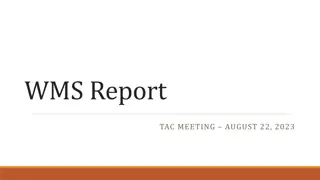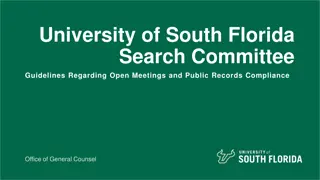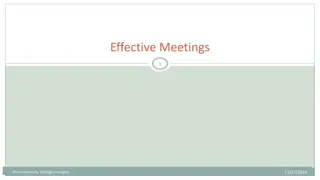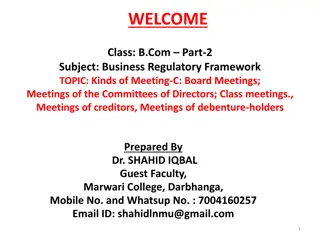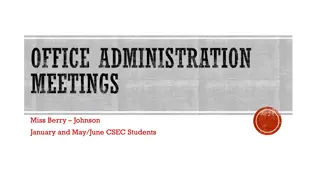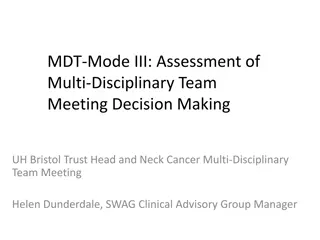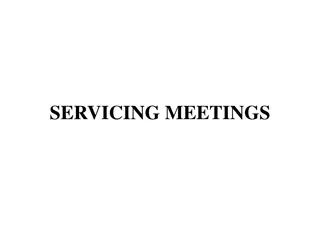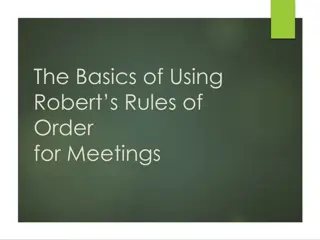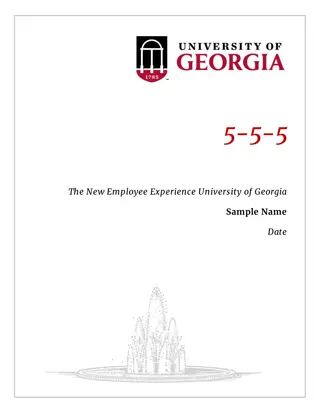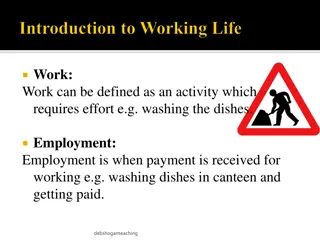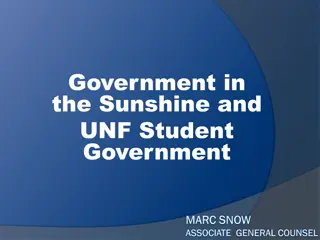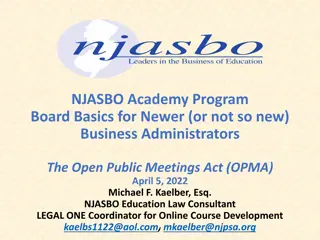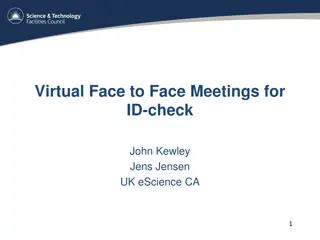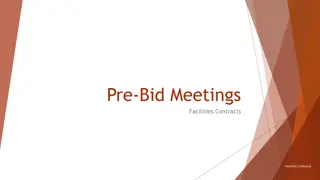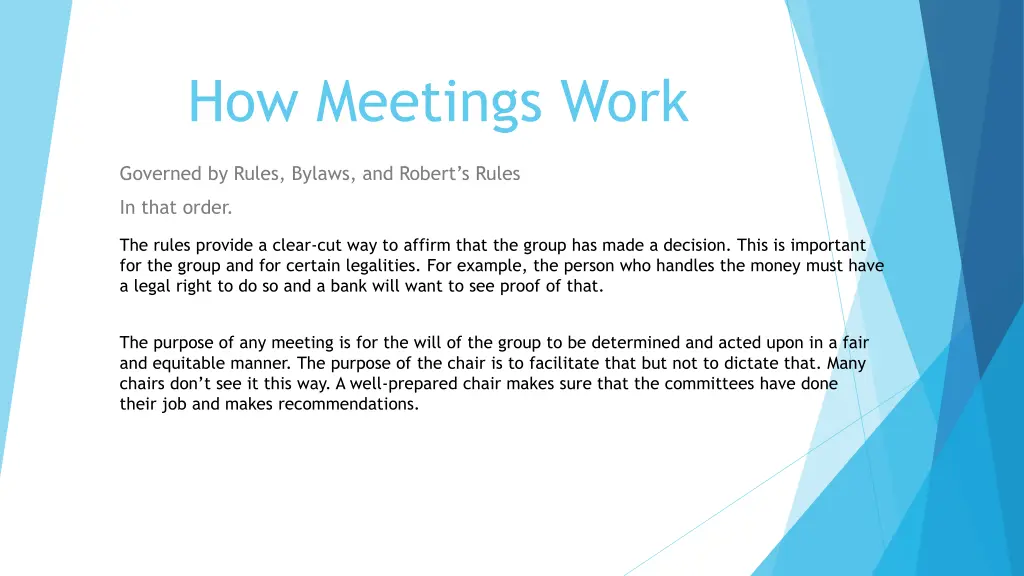
Effective Meeting Dynamics: Rules, Motions, Speakers, and More
Understanding the governance of meetings through rules, bylaws, and Robert's Rules is essential for decision-making and legal matters. Learn about motions, speakers, a bottom-up approach, and key aspects like getting the floor and making motions in an orderly manner.
Download Presentation

Please find below an Image/Link to download the presentation.
The content on the website is provided AS IS for your information and personal use only. It may not be sold, licensed, or shared on other websites without obtaining consent from the author. If you encounter any issues during the download, it is possible that the publisher has removed the file from their server.
You are allowed to download the files provided on this website for personal or commercial use, subject to the condition that they are used lawfully. All files are the property of their respective owners.
The content on the website is provided AS IS for your information and personal use only. It may not be sold, licensed, or shared on other websites without obtaining consent from the author.
E N D
Presentation Transcript
How Meetings Work Governed by Rules, Bylaws, and Robert s Rules In that order. The rules provide a clear-cut way to affirm that the group has made a decision. This is important for the group and for certain legalities. For example, the person who handles the money must have a legal right to do so and a bank will want to see proof of that. The purpose of any meeting is for the will of the group to be determined and acted upon in a fair and equitable manner. The purpose of the chair is to facilitate that but not to dictate that. Many chairs don t see it this way. A well-prepared chair makes sure that the committees have done their job and makes recommendations.
Motions Motions for action arise out of these recommendations. When a committee completes its report, the chair leads the body through the list of recommendations. The chair states the recommendation and gives the body a chance to make a motion concerning it. But the chair does not make the motion, nor does the chair ask for a motion. If no one stands to make a motion, the chair moves to the next recommendation.
Speakers and Programs Any speakers or special programs fall outside the normal business meeting agenda, technically speaking. The order of business is suspended for the special time and resumes when it is completed. Can be near the beginning or near the end.
Bottom Up Approach Getting the Floor Making a Motion Debate Voting Shortcuts Jump-starting a mass meeting Standard meetings
Getting the Floor Meetings must be orderly and only one person can speak at a time. The person who has the moment to speak has the floor . One asks for the floor by standing and saying Mr./Madam Chairman . The Chair is the traffic cop. The Chair determines the next speaker by recognizing one of the people who just stood and asked for the floor. A good chair recognizes the first person who stood and requested the floor. The chair sometimes must pick a tie-breaker. When a person finishes speaking, the rising for recognition begins again. Technically, it doesn t make sense to preset an order of speaking from the set of floor-seekers at any given moment because what any given speaker says may change the desire of subsequent floor-seekers to want the floor or it may induce others to desire the floor. If someone has the floor, you can t stand until they finish their statement.
Motions This is how an opportunity to decide something is put before the group. The best practice is to have motions in written form unless they are extremely simple. That way they can be precisely communicated. Remember, the decisions of the body can have legal implications so precision is necessary. At an appropriate point in the proceedings (when there is no other motion before the body), the person desiring a decision by the body seeks to get the floor (see above). When the recognition is granted, the person says I move that and states what the body needs to decide. Most normal motions require a second. The person seconding does not have to stand. They can simply say, Second, when the person making the motion finishes stating the motion. Having a second makes sure that the body doesn t consider anything if only one person is interested in it. Remember that the body is voting on the exact language of the motion as if it were a law, not on a vague idea. And it isn t the secretary s job to interpret the motion. Neither should there be an explanation of the motion at the time it is made, just get the words recorded. The time for explanations come later. The secretary enters the exact words of the motion into the minutes. If the motion is written, a copy can be given to the Secretary and Chair now. The Chair states the motion and asks, Are you ready for the question? At this point, debate, if any starts. Many people may seek the floor now, but the person making the motion has precedence if he/she wants the floor. The debate proceeds under the debate process (see below) until the time comes to vote.
Debate Debate proceeds as one person after another is recognized and speaks. Time limits may apply per the rules of the organization or the default of Roberts Rules. The Roberts Rules default is a 10-minute limit per speech with any individual only allowed to speak twice on any given question. If a person wanders from the subject of the motion, they can be declared out of order and have their speech truncated by the chair. The speeches must address the issue, not personalities. It is not good decorum to call a person s statements false. Rather say, there is strong evidence that the member is mistaken. Speak to the chair as if he/she were the person whom you needed to convince (even if that isn t the actual case, you are persuading the body). While it may seem stilted, it is good practice to not refer to anyone by name but rather by their office (the previous speaker, the Treasurer, the Secretary). Debate is closed when no one seeks the floor anymore. The Chair signals that debate is about to be closed by asking, Are you ready for the question? That s the last call for anyone to seek the floor. If no one does, the Chair proceeds to take the vote. Debate can be forcibly closed if a person gets the floor and says, I move the previous question. This is a call to see if the assembly is tired of debating and wants to go ahead and vote now. The Chair takes an immediate vote to see if the assembly is ready to stop debate. It takes a 2/3 majority to close debate. During debate (and at other times), there are some higher precedence motions that cane temporarily interrupt the debate. Requesting a point of information can interrupt a speaker and be done without being recognized.
Other things to do with a motion Lay it aside temporarily Close debate Limit or extend debate Postpone to a certain time Refer to a committee Change the wording Kill the main motion Divide the motion into several parts And others
Voting Most motions are adopted or rejected by a majority vote. But some require a 2/3 majority. If a motion seems to be uncontroversial, the chair can do a simple voice Yea or Nay vote. The chair then rules on how the vote went. If anyone on the floor is concerned that the voice vote may not show a clear and proper majority or that the chair is mistaken on their determination of the vote, they can ask for a division of the house. This means that the chair must conduct a counted vote.
Shortcuts This process can be tedious and there are ways to speed it up for routine matters. An agenda provides a list of motion to be considered. When an agenda is adopted it must be followed unless the body suspends it with a 2/3 vote. Nonetheless, someone in the body must move each item on the agenda at the appropriate time for it to be considered. If there is no motion, there is no vote and the item is not considered and the chair moves on to the next agenda item. Some items like minutes can be accepted without a formal motion if no one objects to doing that. The chair says, If there is no objection, we will accept the minutes (or whatever) as presented. If there is a single objection, then the chair must go into the whole motion, debate, and vote process. Really routine stuff can be handled with a consent agenda . A consent agenda is a bunch of stuff that can be voted on as a block without discussion. If any individual wants the body to consider any item on the consent agenda separately, it is moved to the regular agenda with no need to justify it. The desire by any member to move it is sufficient to have it moved.
Jump-starting a meeting when there is no pre-existing organization Someone called the meeting. They can call the meeting to order. The person calling the meeting is not automatically the chair. The group should authorize someone for that position. This can be done with a by a motion or by a nomination process. Once you have a chair, you can repeat the above to authorize a secretary. If you don t have a secretary, your meeting will have no official record and whatever you do will not matter.
Standard Meetings This is where we put all this together. Below is a simple order of business. The chairperson of a meeting should prepare in advance a list of the order of business or agenda for the meeting. A sample order of business follows: Call to Order Adoption of the Agenda Minutes Executive Minutes Treasurer s Report Correspondence (listed) Unfinished Business (listed) Committee Reports (listed) New Business (listed) Announcements (listed) Program (An alternative is to have a guest speaker make his/her comments before the business meeting begins so that he/she does not have to sit through the meeting.) Adjournment
Call to Order The chairperson calls the meeting to order with such a statement as: The meeting will now come to order. If the president is not present, the meeting may be called to order by the vice president, or by any person those attending are willing to accept as chairperson or acting-chairperson. Adoption of the Agenda In some associations it is the practice to circulate copies of the agenda of the meeting in advance. Alternatively, it may simply be written on a chalkboard. In either case the meeting should begin with the consideration of the agenda. The chairperson will ask if any of the members have additional matters that should be placed on the agenda. After these have been taken care of, the chairperson should call for a motion to adopt the agenda. A member should then move: That the agenda be adopted. (Or adopted as amended. ) A seconder is required. Passage of the motion (requiring a simple majority) restricts the business of the meeting to items listed on the agenda. Many of the less formal associations do not bother with consideration of the agenda in this way.
Adoption of the Agenda In some associations it is the practice to circulate copies of the agenda of the meeting in advance. Alternatively, it may simply be written on a chalkboard. In either case the meeting should begin with the consideration of the agenda. The chairperson will ask if any of the members have additional matters that should be placed on the agenda. After these have been taken care of, the chairperson should call for a motion to adopt the agenda. A member should then move: That the agenda be adopted. (Or adopted as amended. ) A seconder is required. Passage of the motion (requiring a simple majority) restricts the business of the meeting to items listed on the agenda. Many of the less formal associations do not bother with consideration of the agenda in this way. However, the procedure outlined above protects the membership from the introduction, without prior warning, of new, and perhaps controversial, matters of business. If a meeting does adopt an agenda, it can change that agenda only by a formal motion to do so. A member might move, for example, that an item be added to the agenda or deleted from the agenda or that the order in which the items are to be discussed be changed. Such a motion must be seconded and requires a 2/3 majority vote. (See Orders of the Day .)
Minutes If the minutes have been duplicated and circulated to members before the meeting (a desirable procedure), they need not be read at the meeting. The chairperson asks if there are any errors in or omissions from the minutes. Some organizations prefer to have a formal motion to approve the minutes. A member should move: That the minutes of the (date) meeting be approved as printed (or circulated). In less formal meetings it is sufficient for the chairperson, if no one answers his/her call for errors or omissions, to say, There being no errors or omissions, I declare the minutes of the (date) meeting approved as printed. Should there be a mistake in the minutes, it is proper for any member to rise and point out the error. The secretary should then make an appropriate correction or addition. The motion will then read: ...approved as amended.
Executive Minutes Sometimes the minutes of the previous executive meeting are read or summarized by the secretary. One purpose is to give information to the membership on the disposition of less important items of business that have been handled by the executive. Occasionally a member will ask for more information regarding the matters disposed of by the executive, and sometimes the general meeting will want to change the action taken by the executive. Such cases are usually rare, but they are indications of the necessary subservience of the executive committee to the membership as a whole. On important matters of business the executive committee may have been able to arrive at recommendations that can later be considered by the general meeting. The reading or summarizing of the executive minutes can therefore prepare the membership for the discussion of important business on the agenda of the general meeting. The executive minutes are not adopted or amended until the next executive meeting (having been read to the general meeting for information only).
Treasurer The chairperson will call upon the treasurer to present a report on the finances of the association. For a regular meeting this need be only a simple statement of the receipts and disbursements since the last financial report, the balance of money held in the account of the association, and some information about bills that need to be paid. At the annual meeting the treasurer should submit a detailed record of the financial business of the year and this report should be audited (that is, checked thoroughly by at least one person other than the treasurer, to ensure that they present fairly the final financial position of the association and the results of its operations for the year). Although it is not necessary to have a motion to adopt the treasurer s report at a monthly meeting, it is advisable to adopt the audited annual report. The treasurer should move: That this report be adopted.
Correspondence Before the meeting, the secretary, in consultation with the chairperson, should separate the letters received into two groups those requiring action and the others. Those letters that will probably require no action are summarized by the secretary. Usually it is sufficient to have one motion That the correspondence be received and filed. Those letters that require action by the meeting will be read or summarized one at a time. The chairperson may state, after each has been read, that action on this letter will be delayed until New Business, or he/she may prefer to have discussion of each letter immediately after it has been read. Each letter in this group will require a separate motion to dispose of it.
Unfinished Business Any business that has been postponed from a previous meeting, or that was pending when the last meeting adjourned, is called old or unfinished business or business arising from the minutes. It is usually advisable for the chairperson to remind the meeting of the history of this business before discussion begins (or he/she may call upon someone with special information to do this).
Committee Reports Before the meeting, the chairperson should check with committee chairs to determine which committees or task forces have reports ready for the meeting and the importance of the material to be presented. All reports must be listed on the agenda. In establishing the order in which committees should be heard, the chairperson should give priority to those with the most important reports. If none of the reports is of particular importance, any committee report that is pending from the previous meeting should be heard first. Usually, standing committees are given precedence over task forces (a standing committee is one that functions over an extended period of time; a task force or ad hoc committee is set up to deal with a special problem and is discharged when its task is completed). Committee reports should be in written form, so that a copy can be placed in the association s files. There is no need for a motion to receive a committee or task force report. The adoption of the agenda has guaranteed that the report will be heard. If the report has been duplicated, the committee or task force chairperson should not read the report. He/she may want to make a few comments, however, before answering questions from the meeting. After all questions have been answered, the committee or task force chairperson will move any recommendations on behalf of the committee or task force. Robert s rules indicate that a seconder is unnecessary for such motions, because the motion is being made on behalf of a committee. Amendments to the recommendations may be proposed by any member at the meeting. After all the recommendations have been dealt with, motions may be received from the floor dealing with the substance of the report or the work of the committee or task force concerned. Note: A committee or task force report need not be adopted. On rare occasions, says Robert s Rules of Order, a meeting may have occasion to adopt the entire report. An affirmative vote on such a motion has the effect of the meeting s endorsing every word of the report including the indicated facts and the reasoning as its own. The treasurer s audited annual report should be adopted. Occasionally it becomes evident that the report of a committee, or one of the recommendations, is not acceptable to a large proportion of the membership present at the meeting. The committee can be directed to review its work in the light of the discussion heard.
New Business When all unfinished business has been disposed of, the chairperson will say: New business is now in order. Items not included on the agenda may not be discussed unless the agenda is amended. (The motion to amend the agenda requires a two-thirds majority.) Announcements or For Good of the Order The chairperson should give committee chairs and others an opportunity to make special announcements as well as making any of his/her own.
Program When the association is to hear a special speaker, it may be advisable to have the speaker before the official business (from Adoption of the Agenda on) begins. In other cases the program occurs after pending new business has been disposed of. The chair of the meeting may ask a separate program chairperson to take charge at this point. Adjournment In organizations with a regular schedule of meetings a motion to adjourn is a privileged motion that is neither amendable nor debatable. A seconder is required and the motion should be put. If it is passed, the chair should announce formally that the meeting is adjourned.
Online Resources http://www.rulesonline.com/ http://www.parli.com/newsletter/the-perfect-one-hour-meeting Amazon: https://www.amazon.com/Roberts-Rules-Order-Newly- Revised/dp/030682020X/ref=sr_1_1?ie=UTF8&qid=1482992258&sr=8- 1&keywords=RONR


